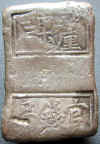A Li Tax Square Trough Cast by The Hunan Monetary Bureau for Inter-governmental Repayment
Weight: 326 grams/9 taels
Date: N/A
Inscriptions: 釐課/官錢局
"L'i" Tax
(Hunan) Official Monetary Bureau
A few pieces of sycee which are ex Su Yin Tang's collection were offered for bidding on a Taiwan auction website in the early 2002. Among them, there was a Hunan 10 tael Square Trough which is similar to the one shown above caught many people's attention. According to the auctioneer, the estimated value of that piece, as well as its initial bidding price, was NT$150,000 (equivalent to US$4,500, according to the exchange rate at that time), which is about 5 times higher than that of an ordinary Hunan Square Trough.
The debates on whether the estimated value is overestimated did not come to an end even after the auction was closed. But, asking for a considerable premium for this piece over other Hunan counterparts, however, is not unreasonable or baseless. It is not just because of the fame of the Su Yin Tang collection, what more important is on the unique historical play role that piece of sycee used to represent.
The Hunan Monetary Bureau was founded in the 29th year of Kuang Hsu (1903), and one of its missions was to issue paper notes denominated in silver tael, silver dollar and copper coin in order to diminish the currency shortage suffered by the province. Reportedly, the denomination of sycee notes issued by the bureau, before it was reorganized as the Hunan Provincial Bank in 1912, totaled more than 2 million taels.
Most of the issued sycee notes were aided to the needs of various commercial activities and daily transactions in the province as planned. By using the sycee notes, businessmen were able to balance their accounts without handing in and out cash sycee. And, if needed, any holder of a sycee note would be paid for cash silver in an amount as denoted by presenting the note to an agent of the bureau. According to our observations, a few types of sycee relating to Hunan Monetary Bureau were cast for such purpose, including a kind of Silver Cake in 1 tael, and Square Troughs in 5 and 10 taels.
Another mission of issuing the sycee notes was for taxpayers to use them as a means to pay against taxes and duties. As stipulated on the reverse of each sycee note, any holder of the sycee notes may also use them to pay against Land & Poll tax, Customs tax, Li tax and so forth. Subsequent to the compliance of such stipulation, many of the sycee notes would be paid to the competent authorities in Hunan by taxpayers, and it would then become liabilities of the Hunan Monetary Bureau to repay those tax payments represented by the sycee notes in cash sycee. Obviously, the specimen in discussion was cast by the Monetary Bureau as repayment to the Li Tax Bureau for those Li tax collected in the form of the sycee notes.
This specimen and its type therefore can not only be considered as a kind of tax silver, but also a representation of inter-governmental repayments. For the latter, they are the first and only examples among all Chinese sycee we know by far.
That piece of sycee, however, was not sold out when the auction ended. Perhaps, it takes time for collectors to appreciate the sycee from its historical value.
Return to Sycee Talks
